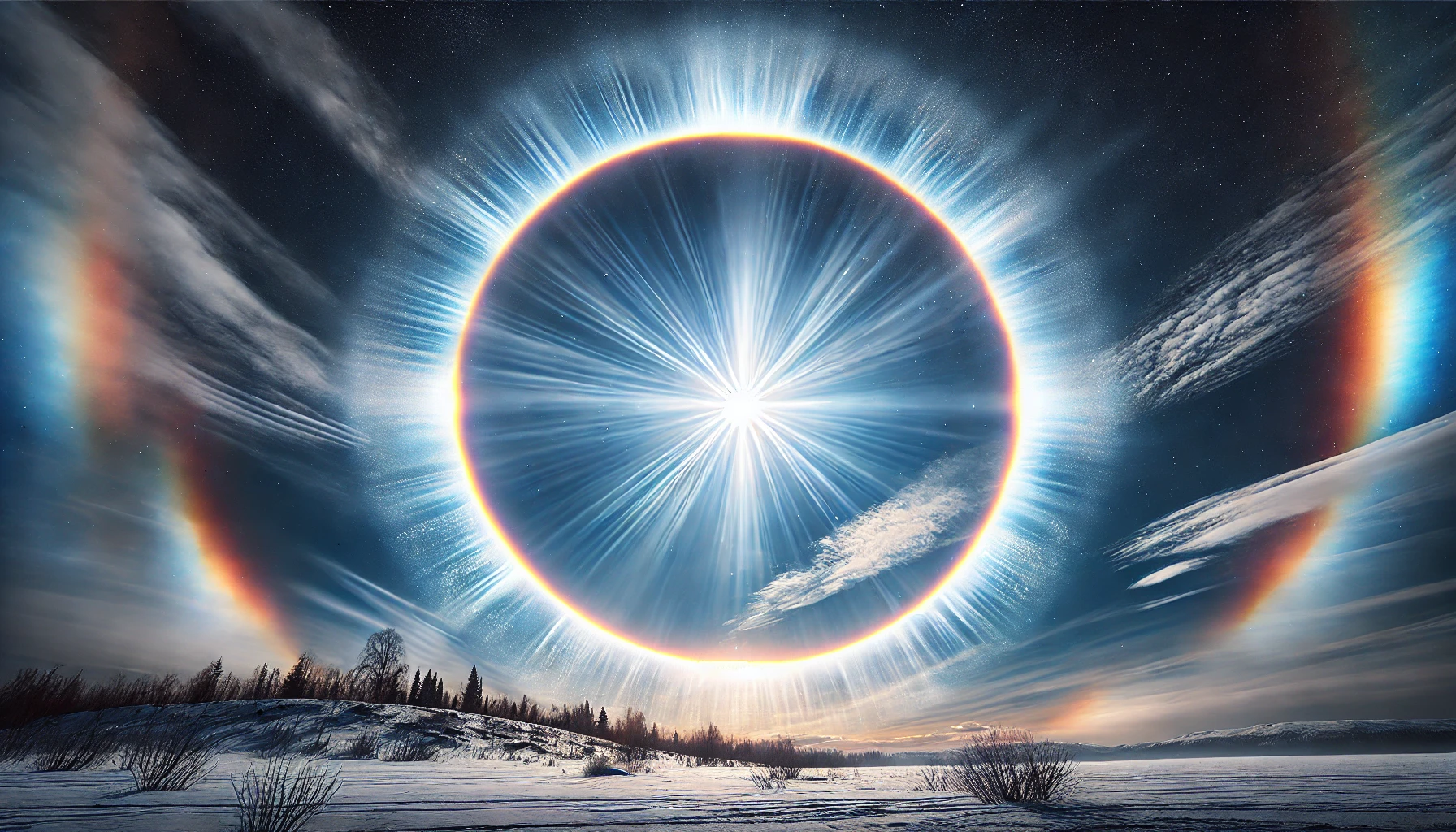The halo phenomenon is a stunning optical event that occurs in the sky, creating a luminous ring around the sun or moon. These halos, often referred to as ice halos, form when sunlight or moonlight interacts with ice crystals in the atmosphere, typically in cirrostratus clouds. The result is a circular ring of light that can display vivid, rainbow-like colors, making it one of nature’s most beautiful and awe-inspiring spectacles.
What is the Halo Phenomenon?
A halo is a bright, often colorful ring that encircles the sun or moon. It occurs when light is refracted (bent) through ice crystals that are suspended in high-altitude clouds. These crystals, typically hexagonal in shape, act like prisms, bending the light at specific angles to create the halo effect.
There are several different types of halos, but the most common is the 22-degree halo, which is a ring that appears 22 degrees away from the sun or moon. Other halo types include sundogs (bright spots on either side of the halo), moonbows (a lunar version of the halo), and halos around the moon which are less common but equally captivating.
How Do Halos Form?
The formation of halos is a fascinating process that relies on the behavior of light passing through ice crystals in the atmosphere. When sunlight or moonlight enters the ice crystals, it bends at a specific angle—usually 22 degrees. As the light is refracted, the crystals also reflect and scatter the light, creating the visible halo effect.
The size and brightness of a halo depend on various factors, including the size and orientation of the ice crystals, the density of the clouds, and the angle of the light source. Halos are most commonly seen in cirrostratus clouds, which are thin, wispy clouds that occur at high altitudes.
Types of Halos
- 22-Degree Halo: The most common and widely recognized halo, this phenomenon appears as a circular ring around the sun or moon, located 22 degrees away from the light source. It is often bright white but may also show faint colors on its edges.
- Sundogs (Parhelia): These bright spots occur on either side of the sun and are often seen in conjunction with a 22-degree halo. Sundogs appear when sunlight refracts through ice crystals at a 22-degree angle, creating a pair of luminous spots in the sky.
- Halo Around the Moon (Lunar Halo): Similar to the solar halo, this phenomenon forms around the moon when moonlight is refracted through ice crystals in the atmosphere. Lunar halos are typically faint and can appear as a ghostly ring, often seen in winter months when the sky is clear and cold.
- Moonbow: A rarer type of halo, moonbows form when the moon’s light is refracted through rain or water droplets, producing a rainbow-like effect, but the colors are typically much dimmer than those of a daylight rainbow.
- Halo with Multiple Rings: In some cases, halos can appear with multiple rings, often stacked around the light source. These can include both bright and faint rings, depending on the conditions and the angle of the refracted light.
When and Where Can You See Halos?
Halos can be seen anywhere in the world, but they are most commonly observed in areas with cold weather, especially during the winter months when cirrostratus clouds are more frequent. They are often seen during clear, sunny days, or on nights when the moon is bright enough to produce visible moonlight.
In particular, halos are commonly seen in regions with cold climates, such as the Arctic, mountainous areas, and polar regions. They can also occur in locations where high-altitude clouds frequently form, such as near coastal areas with cooler temperatures.
Why Are Halos Important?
Halos are not only beautiful natural phenomena but also serve as indicators of specific weather conditions. The presence of a halo often signals the presence of cirrostratus clouds, which may indicate that a weather front is approaching. This is especially true for the 22-degree halo, which is often seen in advance of a storm or change in weather patterns.
For many cultures, halos have also held symbolic meanings. They are often viewed as signs of divine presence or supernatural events, which is why halos appear frequently in religious artwork, particularly in depictions of saints and other holy figures.
How to Photograph the Halo Phenomenon
Capturing the beauty of halos in photography requires patience and the right conditions. The best time to capture a halo is on a clear, sunny day or a moonlit night when the sky is free of heavy clouds. To photograph the halo, ensure that your camera settings are adjusted to account for the bright light source and the faint rainbow hues of the halo.
A wide-angle lens is useful for capturing the full circular effect of the halo, and it’s important to be mindful of glare, as it can interfere with the clarity of the photograph. When photographing halos around the moon, long-exposure shots can help capture the full brilliance of the phenomenon.
Conclusion: The Wonder of the Halo Phenomenon
The halo phenomenon is a striking example of nature’s ability to create beauty through simple optical effects. These colorful rings around the sun and moon are not only breathtaking to observe but also provide valuable insights into atmospheric science and the behavior of light. Whether seen as a weather indicator or as a symbol of something greater, halos continue to captivate those fortunate enough to witness them. Another amazing phenomenon is the fata morgana mirages.

